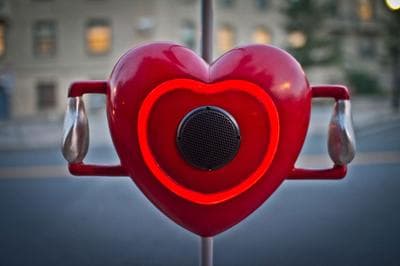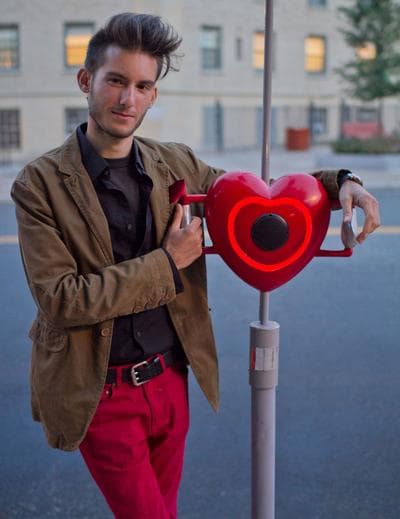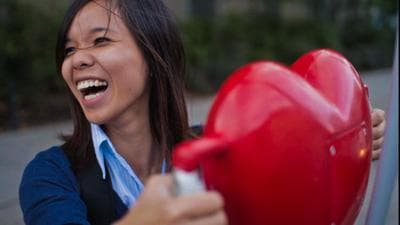Advertisement
Public Art Goes Missing A Day After Debut; City Vows To Replace It

About a week ago, just after a new public art project called “Pulse of the City” debuted at five locations around Boston, one of the electronic musical hearts disappeared from Christopher Columbus Park in the North End, where Mayor Thomas Menino had participated in a reception for the project the day before.

“It went missing around Saturday,” Sept. 7, says the artist leading the project, George Zisiadis, who graduated from Harvard University in 2011 and is now based in San Francisco. “It’s unfortunate. … We made the piece to bring joy and happiness to the residents of Boston.”
“We’re disappointed that this has happened, but we’re not convinced we can’t go forward,” says Karin Goodfellow, director of the Boston Art Commission. “It’s certainly a learning process. We’re all a little surprised.”
Meanwhile another one of the hearts in front of the new East Boston Neighborhood Health Center in Maverick Square was also damaged.
“We’re replacing the one that got stolen. And the East Boston one and all the other ones are going to be reinforced,” Goodfellow says. “It’s been a very popular project for the short time it’s been up.”
“Pulse of the City” debuted as a “cardboard and auto body putty” contraption at the Urban Prototyping Festival in San Francisco a year ago, where Zisiadis says a city official from Boston was impressed enough to encourage colleagues to bring it here.
“In less than a year, it’s gone from this mere idea to enthusiastic reality,” Zisiadis says. “It shows the power of cities to rapidly innovate.”
The artworks are red heart-shaped sculptures, solar-powered, and mounted on poles. They have speakers in the center and handles on the sides. “You hold onto the handles and it detects your pulse and it plays back to your heartbeat unique music for you there and then,” Zisiadis says. “In today’s cities, there’s so much happening all around us that it’s easy to lose track of what’s happening within us. … I wanted to help people reconnect with the rhythm of their bodies.”

Other “Pulse of the City” locations around Boston include Ashmont Station in Dorchester; along the circle at Avenue Louis Pasteur in Longwood; and in front of the Reggie Lewis Athletic Center in Roxbury.
Zebbler Studios in Boston, which produces eye-popping digital animations, video installations and stage light shows, was hired to maintain the project here. Peter “Zebbler” Berdovsky is perhaps best known for sparking a panic when LED devices he surreptitiously installed under bridges and on various other greater Boston infrastructure as guerilla advertisements for an “Aqua Teen Hunger Force” movie in 2007 were mistakenly suspected by jumpy government authorities to be bombs.

Zebbler Studios sent out invitations to a Sept. 6 opening reception at Christopher Columbus Park: “This historic meeting of these formerly bitter foes, Zebbler and Menino, will be served with heart-shaped cookies of love. For this city prevails and unites us all.”
More than 1,000 people had tried the devices around the city by the end of the first weekend, Zisiadis says. “It really shows the magic of what can happen when we make public space fun, playful and engaging,” he adds.
The heart design is whimsical, but “it’s actually an incredibly complex piece of machinery,” says Zisiadis, who had help with fabrication, engineering and sound help from Rachel McConnell, Matt Ligon, Rich Trapani and featuring music by Rich DDT, JPOD, Mochipet, NVO, William S. Braintree, Biomigrant, Henry Strange, Solillaquists of Sound, Indigo, and Gabriel Goldberg.
The city-funded project initially cost $25,000, but is expected to require another $5,000 to replace the missing heart and reinforce all of them, Goodfellow says. She expects the remaining pieces to be reinforced by this week. Zisiadis expects a replacement heart to arrive for the North End in a few weeks. The plan is to keep them up for a year.
“As far as the city’s commitment at this point, that’s still strong. We’re still excited,” Goodfellow adds. “It is a new way for us to do public art.”
This article was originally published on September 17, 2013.
